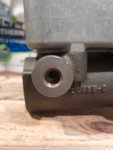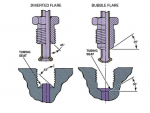I've explained it in post #83. You have to have two air packs.
What fleetmech mentioned and jeepsinker is using a air actuated MC from a trailer to split the brake system. My concern is that if you lose the main MC, you've lost your trailer brake MC. Because no fluid pressure into the airpack means no air out of the air pack. And you're back to no brakes again with no gain.
I understand now, thanks! And I also understand now why an emergency spring brake failsafe was discussed. The problem with that failsafe is that without somehow splitting the front hydraulic brakes from the rest of that part of the system,
all the brakes would be slammed on air loss, creating a major control issue due to front wheel lock-up. Now we're back to splitting the air system like the stock dual-circuit setup

To make this really work safely, the brake pedal would have to be set up like a vacuum brake pedal on a car, with the MC piston in-line with both the MC and the booster so that if the booster fails, the pedal would still directly work the hydraulics. I don't know if that kind of air-hydraulic pedal-MC setup exists - haven't looked it up yet.
The Hydro-Max booster you mentioned does that, but needs a hydraulic pump of some kind to work. I suppose you could use an electric pump to make it work instead of installing a belt-driven hydraulic pump if one wasn't going to install hydraulic power steering. Even if the electric pump quit working you'd still have unassisted brakes left.
Hmmm, the M39 and M809 5-tons have a hydraulic power steering pump. How hard would it be to install a Hydro-Max booster in one of those to get split-circuit brakes?






